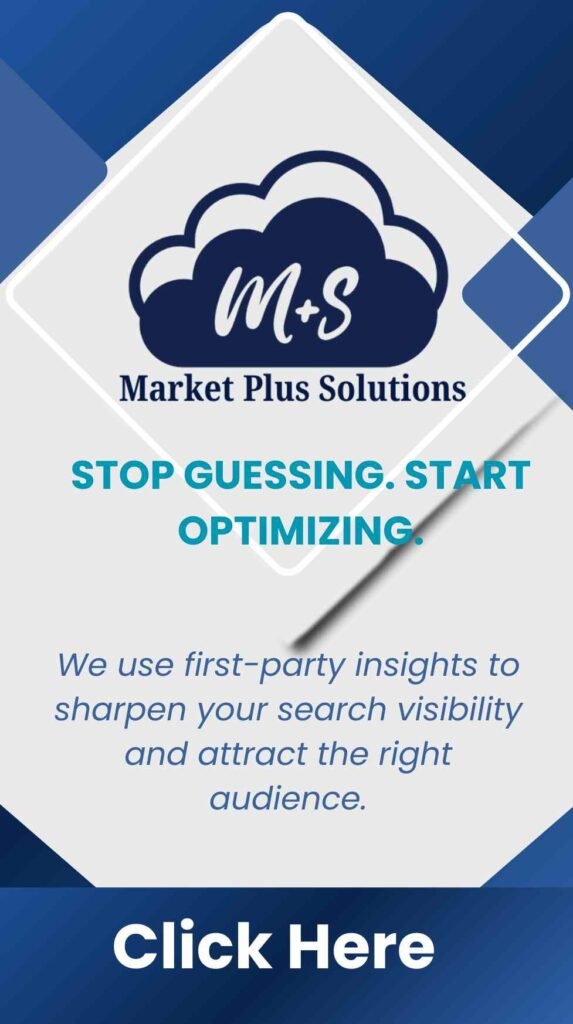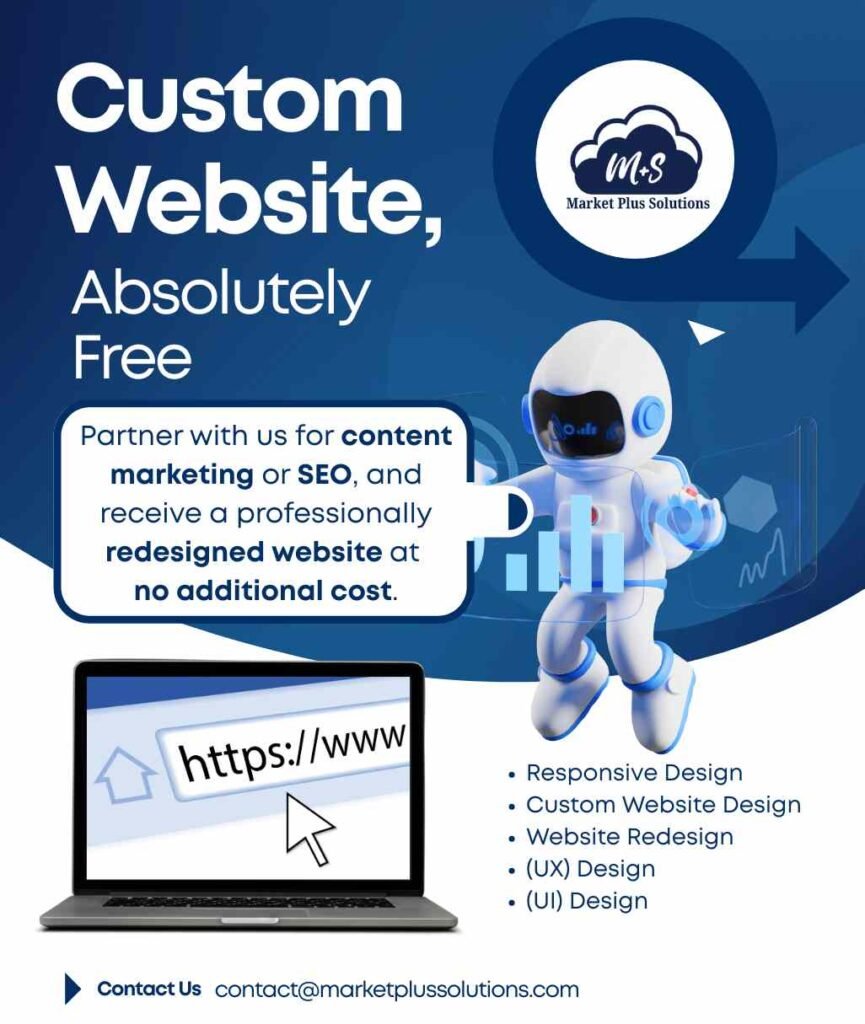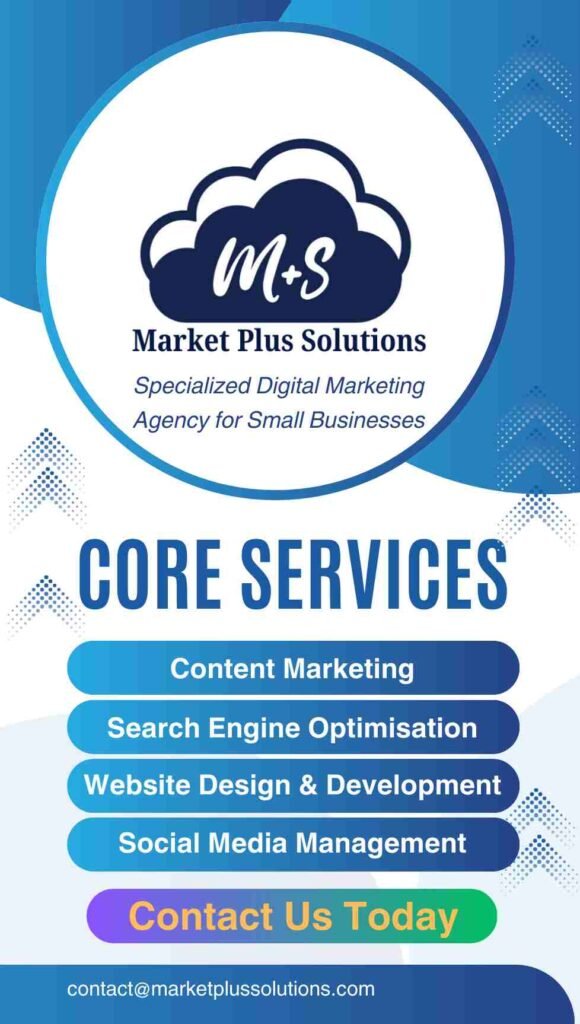First-Party Data Strategy
A first-party data strategy is the foundation of sustainable, privacy-first marketing in 2025.
It’s how modern businesses responsibly collect, manage, and activate data that users share directly—through websites, mobile apps, email interactions, CRM platforms, and product usage.
But building a strategy is about more than gathering information.
(We have recently covered First-Party Data Marketing in detail – click here)
It’s about connecting the dots between data privacy compliance, content, segmentation, and performance. When done right, a first-party data strategy transforms raw customer inputs into personalized, high-impact marketing—without compromising trust.
At its core, this is a shift in mindset.
You’re no longer dependent on third-party data or opaque algorithms.
You’re creating a marketing ecosystem built on transparency, relevance, and customer data privacy.
The outcome?
Smarter campaigns, stronger conversions, and long-term growth—powered by data you own and customers trust.
What Is First-Party Data and Why Does It Matter?
Before you can build a strong first-party data strategy, you need to understand what you’re working with.
First-party data is the information your business collects directly from its audience—through interactions on your website, mobile app, email campaigns, CRM systems, surveys, and customer support channels. Because this data is voluntarily shared and tied to real behavior, it’s accurate, contextual, and inherently aligned with data privacy compliance standards. (click here to learn more about how to increase website traffic on a startup budget)
Around 90% of U.S. consumers respond positively to personalized marketing—highlighting the importance of using first-party data in a way that respects privacy and consent. (vaimo)
Unlike third-party data—which is often aggregated, purchased, or scraped from external sources—first-party data puts you in control. You know exactly where it came from, how it was captured, and how it maps to your customer journey. That transparency is essential—not just for privacy, but for performance.
Why does this matter now more than ever?
Because today’s customers expect more.
They want personalization without intrusion, relevance without risk.
They’re more aware of their customer data privacy rights, and they’re actively choosing brands that respect those boundaries. At the same time, global regulations like GDPR and CCPA, along with the decline of third-party cookies, are forcing a long-overdue shift in how businesses handle user data.
A well-designed first-party data strategy helps you meet these expectations head-on.
It allows you to deliver tailored, high-performing experiences—while staying compliant, ethical, and future-ready. You’re not just collecting data; you’re building trust. And that trust is what turns anonymous traffic into loyal customers—and marketing into measurable growth.
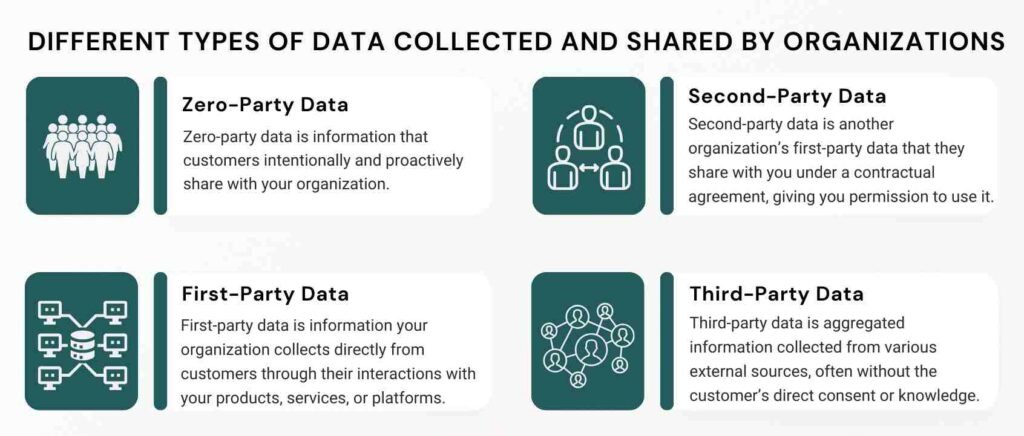
How to Build a First-Party Data Strategy That Works
A high-performing first-party data strategy isn’t built on guesswork or one-size-fits-all templates.
It’s built on structure—a system that transforms raw data into meaningful, measurable outcomes. To do this effectively, your strategy must align five essential components: data collection, consent, storage, governance, and activation.
(Here is SEO and Content Marketing, step by step guide for small businesses in 2025)
Let’s explore what that actually looks like in practice:
1. Start with Intentional First-Party Data Collection
Every digital interaction—whether on your website, app, or product—is an opportunity to collect meaningful, consented data. But capturing that value requires intentional design.
Move beyond static forms. Use interactive tools like quizzes, surveys, chatbots, and behavioral tracking to capture signals tied to real user intent. Lean into progressive profiling to collect data gradually and naturally as engagement deepens.
The goal isn’t more data—it’s better data. The kind that fuels smarter customer segmentation and truly data-driven decision making.
2. Make User Consent Management Seamless
In the world of first-party data strategy, consent isn’t just about compliance—it’s about trust. When users know how and why their data is collected, they’re more likely to share it.
Implement a clear, user-friendly consent management platform (CMP) that allows users to control cookie settings, opt-ins, and communication preferences. Show exactly what data is being used and what value they get in return.
Done right, user consent management enhances both your legal standing and your brand perception.
3. Store Data Securely and Responsibly
What good is great data if it’s scattered across disconnected systems? A successful first-party data strategy depends on secure, centralized infrastructure.
Your CRM integration should consolidate user data from all relevant sources—email platforms, analytics tools, product databases, and more. A well-integrated Customer Data Platform (CDP) ensures accessibility, consistency, and speed across departments.
This creates a single source of truth—critical for effective marketing execution and organizational alignment.
4. Govern Your Data with Clarity and Control
Data without governance is just chaos. You need clear rules about how data is categorized, tagged, accessed, and updated—especially as teams scale and data volume grows.
Create a data governance policy that defines roles, responsibilities, access rights, and compliance monitoring. This not only protects your data—it ensures it remains useful, structured, and scalable.
Governance isn’t the “unsexy” side of data strategy. It’s what makes everything else work.
5. Activate It Across Channels—Intelligently
The most valuable first-party data strategy is the one that gets used. Data becomes power when it drives personalization, automates customer journeys, and informs strategic content across every touchpoint (Learn more about best SaaS Content Marketing Agency here).
Use it to:
Segment campaigns by behavior and intent
Personalize emails, landing pages, and ad copy
Trigger real-time automation
Power omnichannel marketing across web, email, and paid platforms
When you activate your first-party data with intent, you stop guessing—and start delivering experiences that feel timely, relevant, and human.
Bottom line: A structured, well-executed first-party data strategy transforms raw user signals into high-performing, privacy-compliant marketing systems. When these five pillars work together, you’re not just collecting data—you’re building a machine that drives insight, trust, and growth. (Heard of niche SEO? Click here and grow your small business with low competition keywords)
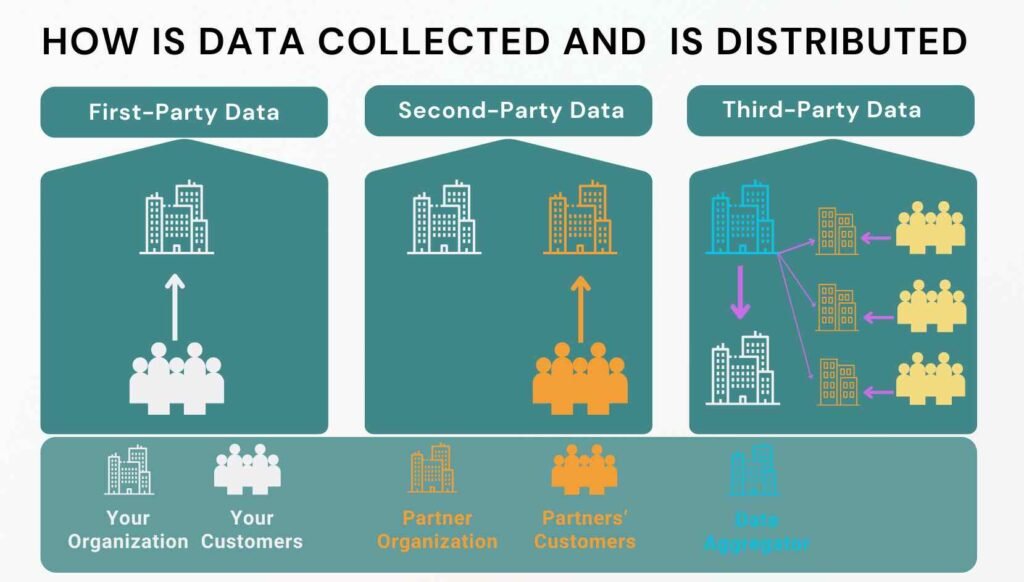
Using First-Party Data to Personalize Marketing
Personalization isn’t optional anymore—it’s the baseline for marketing that works.
(Explore our SEO page for SaaS and IT Businesses here)
But delivering meaningful personalization in 2025 takes more than a first name in an email or a pre-set automation flow. It requires context, consent, and above all, a robust first-party data strategy.
As third-party cookies vanish and customer expectations rise, marketers need precision without overstepping. First-party data marketing delivers just that—giving you the clarity, control, and compliance needed to tailor messaging across channels with confidence.
Here’s how high-performing teams use their first-party data strategy to deliver personalization that actually feels personal:
1. Segment Audiences Using Real-Time Behavioral Signals
Demographics alone won’t cut it. Using first-party data collection, you can create responsive audience segments based on behavior:
- Time spent on high-intent pages
- Feature usage frequency
- Email click patterns
- Funnel abandonment
- Cross-device or channel interactions
This enables data-driven personalization that evolves with your users—without breaching trust.
A survey by Segment found that 78% of businesses view first-party data as their most valuable asset for personalization. From purchase history to on-site behavior, this data offers deep insight into customer preferences and expectations.
2. Create Predictive Campaigns That Anticipate Needs
The best personalization happens before the customer makes a move. Feed structured first-party data into predictive models to surface patterns like:
• Churn risk
• Upgrade potential
• Product affinity
• Preferred content types
This empowers you to deliver targeted messages, content, or offers when they’re most likely to matter.
3. Design Adaptive Website and App Experiences
With a mature first-party data strategy, your digital environment becomes dynamic. Adjust content based on engagement signals (take a look at the SaaS content marketing services here):
• Returning users see saved preferences
• New visitors get onboarding help
• Lapsed users are nudged with relevant updates
This is real-time personalization built into the user experience—not just your marketing funnel.
4. Personalize with Consent, Not Assumption
Compliance builds trust. With a strong user consent management system, you collect data transparently—and personalize accordingly:
• Clear opt-in experiences
• Preference-based content
• Visible data usage policies
A responsible first-party data strategy doesn’t skirt regulation—it makes ethical personalization part of your brand identity.
5. Align Content with Intent, Not Just Demographics
Generic nurture flows waste attention. Use first-party data to align messaging to where users are in their journey:
- Awareness-stage visitors get educational content
- Evaluation-stage leads see comparisons and testimonials
- Ready buyers get demo invites or special offers
This reduces friction, increases conversion, and shows that you’re listening. (click here to learn more about content strategy – ToFu, MoFu, and BoFu funnel)
6. Deliver In-Product Personalization
For SaaS, fintech, and digital platforms, first-party data marketing doesn’t end with acquisition—it continues inside the product:
- Highlight unused features
- Recommend next steps or tutorials
- Tailor dashboards or UI based on user tier
- Prompt upgrades when engagement signals readiness
This makes personalization part of product experience—not just pre-sales messaging.
7. Send Messages When Users Are Most Engaged
Say goodbye to fixed email schedules. With a smart first-party data strategy, you can automate messages based on actual user behavior:
- Last active session
- Interaction frequency
- Time spent on product or content
- Inactivity triggers
This improves campaign relevance, boosts engagement, and shows you respect attention.
8. Build Lookalike Audiences Based on Trusted Data
Without cookies, your best targeting signals come from the customers you already know. Use first-party data to build high-fidelity lookalike audiences on ad platforms like Meta, Google, and LinkedIn. This increases ad efficiency, improves match rates, and minimizes dependency on rented data. (click here to learn how LinkedIn algorithm has changed in 2025)
9. Localize Without Overstepping
Hyper-personalization isn’t always the answer. Use first-party data to deliver tailored experiences through subtle localization:
- Language preferences
- Time zones and regions
- Device and channel behavior
- Culturally aligned offers or tone
This helps you stay personal—without becoming intrusive.
10. Measure, Learn, and Continuously Improve
Even the smartest personalization must be refined. Use insights from your first-party data strategy to evaluate and optimize:
- Segment performance
- Conversion rates by content type
- Best-performing engagement windows
- Overexposure or fatigue signals
The most effective personalization isn’t static—it evolves with your users.
Bottom line: A high-impact first-party data strategy turns fragmented interactions into seamless experiences. It fuels campaigns that respect privacy, optimize performance, and create connections that last. In 2025 and beyond, this isn’t a tactical edge—it’s the blueprint for modern marketing.
According to McKinsey, 71% of consumers expect personalized experiences from the brands they engage with—and 76% feel frustrated when those expectations aren’t met. With alternatives just a click away, delivering relevant, tailored interactions is no longer a nice-to-have—it’s essential.
Benefits of First-Party Data Marketing
First-party data marketing isn’t just a response to cookie deprecation—it’s a smarter, more strategic approach to sustainable growth (click here to explore SaaS growth – compliance and the rise of vertical SaaS). With a strong first-party data strategy, brands can build deeper customer relationships, deliver more relevant experiences, and operate confidently in a world of evolving privacy standards.
Here’s why forward-thinking teams are making first-party data the cornerstone of modern marketing:
1. Privacy-Compliant by Design
First-party data is collected directly from your audience—with full consent, transparency, and control. When combined with strong user consent management, it aligns natively with global privacy regulations like GDPR and CCPA. That means fewer compliance risks, greater brand integrity, and a marketing foundation built on trust.
2. More Accurate, More Actionable
Third-party data often lacks precision—it’s generic, outdated, and disconnected. In contrast, first-party data collection delivers real-time, context-rich insights rooted in actual behavior across your site, CRM, email, and product. That granularity allows for smarter targeting and higher campaign performance.
3. Powers True Hyper-Personalization
Because you control the source, first-party data marketing lets you tailor content, email flows, ads, and product experiences with exceptional precision. From progressive profiling to predictive targeting, your strategy becomes deeply aligned with individual user intent—across every touchpoint.
4. Future-Proof in a Cookieless World
Third-party cookies are fading fast. Platforms are tightening privacy protocols. And ad tracking is increasingly restricted. A well-built first-party data strategy ensures you stay visible and effective—without relying on rented audiences or opaque algorithms.
5. Builds Long-Term Customer Trust
When users understand how their data is used—and actually benefit from it—they’re more likely to engage and stick around. First-party data marketing makes ethical personalization the norm, fostering transparency and long-term loyalty that goes beyond conversion.
6. Boosts ROI and Reduces Waste
With cleaner, more relevant data, you eliminate inefficiencies. Better customer segmentation and smarter targeting mean less spend on poor-fit audiences—and stronger returns from the channels that work. A strategic use of first-party data leads to more impact with fewer resources.
7. Improves Marketing Automation Precision
Marketing automation thrives on real-time signals. When powered by first-party data, you can trigger emails, alerts, and messages based on actual behavior—like clicks, logins, or content engagement—making each touchpoint more timely, relevant, and effective.
8. Enhances Sales and Support Alignment
First-party data isn’t just a marketing asset—it’s a sales and support differentiator. When integrated into your CRM or support platforms, it gives teams insight into user behavior, interests, and friction points—enabling more personalized conversations and faster resolutions.
9. Enables Full-Funnel Measurement
Because first-party data is owned and centralized, you gain visibility across the entire customer journey—from first click to repeat purchase. That makes it easier to attribute revenue, optimize content, and increase customer lifetime value (CLV) over time.
10. Gives You Control Over Your Own Growth
When you rely on third-party platforms, you’re at the mercy of shifting algorithms and rising ad costs. But with a robust first-party data strategy, you own your relationships, insights, and outcomes—giving you long-term scalability and strategic independence.
Bottom line: First-party data marketing isn’t just about checking a compliance box. It’s how modern brands scale with confidence. It powers campaigns that are more human, more efficient, and more aligned with what customers want—now and in the future.
(Click here to explore our website design and development page)
Comparing First-Party and Third-Party Data Approaches
For years, third-party data was the engine behind digital advertising.
It promised broad reach, fast targeting, and convenience at scale. But in 2025, that model is collapsing. Privacy regulations are stricter. Third-party cookies are vanishing. And consumer trust in anonymous tracking has eroded. That’s why more brands are turning to a smarter, more ethical alternative: first-party data strategy.
Unlike third-party data—which is purchased or scraped from external sources—first-party data is collected directly from your audience, with consent and transparency. It’s cleaner, more accurate, and inherently aligned with privacy-first marketing principles.
What you gain is more than compliance.
You gain control—over your targeting, your messaging, and your customer relationships. And in a cookieless world, that control isn’t optional. It’s essential. (click here to explore SaaS marketing challenges – lesson from 2024 and strategies for 2025)
Below is a table compares first-party and third-party data approaches:
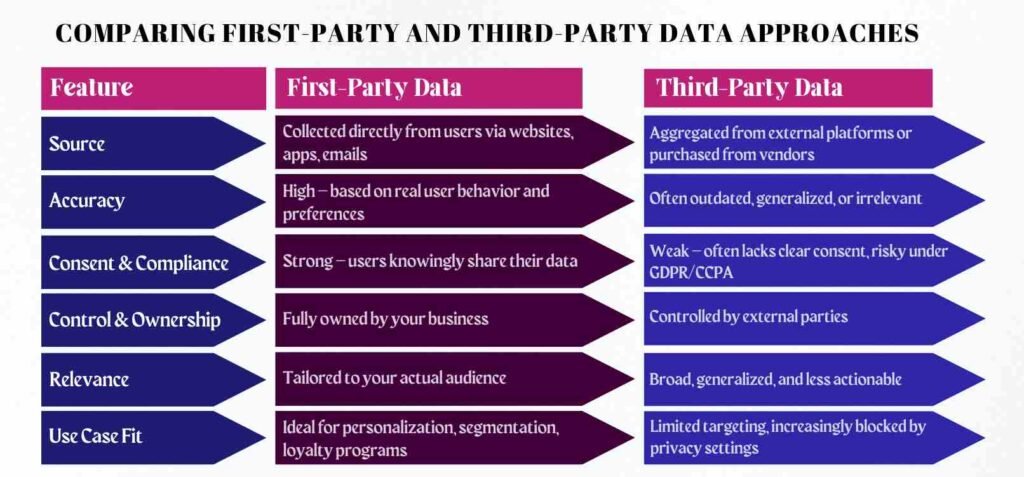
Why First-Party Data Marketing Wins in 2025
The marketing landscape in 2025 is defined by one pivotal shift: control over data has moved back to the user. And the brands that honor that shift—by building a transparent, ethical, and actionable first-party data strategy—are the ones outpacing the rest.
As privacy regulations tighten and third-party data crumbles, first-party data marketing has emerged not just as a safeguard—but as a strategic growth engine.
Here’s why it’s winning now, and why it will continue to lead the future:
1. Trust and Transparency Lead to Loyalty
Consumers are more privacy-aware than ever. They expect brands to explain how data is collected, what it’s used for, and what they get in return. A clear first-party data strategy helps brands:
• Be upfront about data practices
• Offer real value in exchange for insights
• Empower users with control over preferences
This builds customer data privacy into the user experience—making trust not just a value, but a measurable advantage.
2. Privacy-First Marketing Built In
First-party data is collected with consent, making it far easier to align with regulations like GDPR, CCPA, and other regional laws. No legal loopholes—just clean, compliant data that you can build on with confidence.
Brands that treat data privacy compliance as a strategic asset—not a burden—are also building reputations as leaders in ethical marketing. (click here to explore how content marketing can empower your business through thought leadership)
3. Personalization That’s Accurate and Ethical
Because first-party data is based on real actions—site visits, feature use, email clicks—it reflects what users actually want. This allows for hyper-relevant, data-driven personalization without crossing any ethical lines.
No assumptions. No invasive tracking. Just content that fits.
4. Resilience in a Cookieless, Platform-Constrained World
With cookies gone and tracking restrictions increasing, brands that rely on third-party data are losing visibility. But with a strong first-party data strategy, you gain:
• Independence from platform limitations
• Ownership of your insights
• Stable, scalable targeting
First-party data marketing doesn’t just survive the cookieless future—it thrives in it.
5. Platform-Preferred Performance
Ad platforms like Google, Meta, and LinkedIn now reward advertisers who use first-party data. Why? Because it’s timely, accurate, and verified by consent.
The result: better match rates, improved relevance scores, and more efficient ad spend.
6. Stronger Attribution and Measurement
Owning the data journey—from awareness to conversion—means better insight. With first-party data, you can:
• Attribute results across all touchpoints
• Map customer journeys more clearly
• Link performance to revenue with confidence
In 2025, data-driven decision making demands visibility—and only first-party data provides it end-to-end.
7. Better Alignment Across Teams
When data is shared across departments, your marketing becomes smarter—and so does your business. A unified first-party data strategy ensures:
• Sales teams know what leads engaged with
• Support sees the customer’s full history
• Marketing can continuously refine the journey
The result: aligned teams, smoother workflows, and better customer outcomes.
8. Scalable Without Compromise
Growth often dilutes personalization. But first-party data marketing scales without sacrificing relevance or compliance. As your database grows, so does your ability to segment, personalize, and automate—ethically and efficiently.
This is what modern growth marketing looks like: data-rich, privacy-safe, and performance-driven.
Final Word: Why It Wins? First-party data isn’t a fallback—it’s a foundation.
A thoughtful, compliant, and customer-centric first-party data strategy allows you to operate with precision, build trust, and deliver experiences that perform across every touchpoint. In the privacy-first world, it’s not just a marketing upgrade—it’s a business imperative.
Final Thoughts: First-Party Data Strategy Is Your Growth Engine
Let’s be clear: owning your data means owning your growth.
Privacy laws are getting stricter – Third-party data is becoming unreliable – Platforms keep changing the rules.
The only dependable source of insight is the data you collect directly from your customers—with consent and context. A well-structured first-party data strategy gives you that control. It allows you to reach the right people, communicate clearly, and improve performance across every part of your marketing—from content and SEO (learn more about best SaaS SEO agencies here) to email, automation, and analytics. It’s not about keeping up. It’s about staying in control.
It gives you:
- Data you can trust
- Customers who trust you
- Marketing that doesn’t just meet the moment—but leads it
The brands scaling today aren’t chasing anonymous clicks.
They’re building systems that activate data they own—day after day, across every touchpoint.
So if you’re still wondering whether now is the time to invest in your first-party data strategy, here’s the answer:
It’s not just time. It’s already late.


